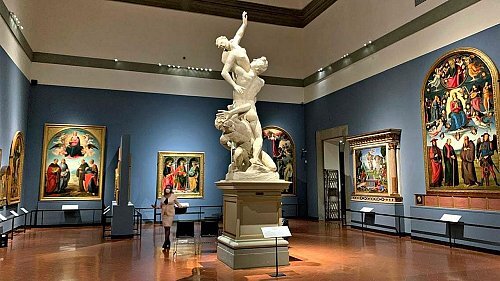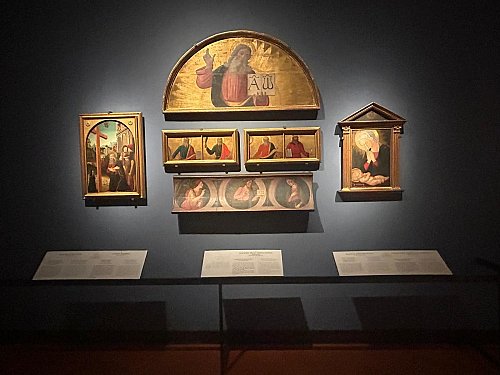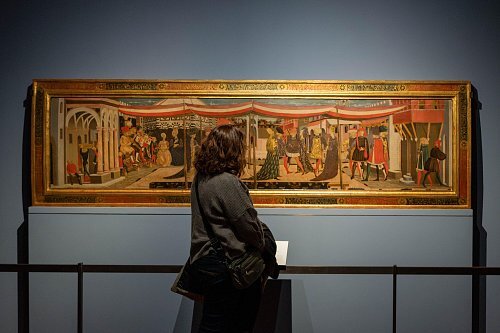Colosso Hall

Visitors enter the Hall of the Colossus at the Galleria, which has been totally redesigned since December 2013.
The first step a visitor takes in the exhibition itinerary of the museum is within the Hall of the Colossus, a vast room whose centerpiece is Giambologna's beautiful terracotta sketch of The Rape of the Sabine Women. This hall gives one see Florentine paintings from the 15th and early 16th centuries. A newly created small room that comes from Hall of Colossus has been worked into seeing these works approached made only to view works dedicated just to 15th century. Masterpieces like Thebaid by Paolo Uccello and Cassone Adimari by Scheggia (Masaccio's brother) will be able to be seen here.
The room took its name in the 19th century when it showed a plaster copy of an old statue—specifically one of the Dioscuri of Montecavallo (Castor and Pollux)—not now on display in the Gallery.
At present, the middle of the hall has the plaster model for Giambologna’s great marble sculpture “Rape of the Sabines” made about 1580.
Giambologna made this model to show his great skill; it was the first time a close-knit set of three figures carved from one big block of marble where people could see it from different angles. The complete original piece was finished in 1582 and seen under the Loggia dei Lanzi in Piazza della Signoria.
On the same wall of the entrance
The plaster by Giambologna is sandwiched between a tremendous treasure of religious art going back to the Late Gothic period and then the early Renaissance from the 15th to the early 16th centuries. The tiny format of the numerous panel paintings hanging on the wall certainly attracts attention. This one wall carries works by masters such as Paolo Uccello, Perugino, Filippino Lippi, Domenico Ghirlandaio, and Botticelli.
Look at first a sight rather large might feel it so that’s, not to worry, as to better absorb take in this impressive collection all There be Two main pieces worth searching for on the wall amongst the sea of Renaissance art: and other is the central piece; the front rectangular panel of a chest, Cassone Adimari.
This panel is one of a pair of marriage coffers linked with the Adimari household and represents an archetypal Florentine Renaissance marriage. It features middle streets; famous monuments, the whole featuring the Baptistery at its left, and sumptuous brocades embodying the tradition and prosperity of the noble families of Florence in the 1450s.


The Left Wall
On the left of the chest, one finds the second masterpiece: a small panel, attributed to Botticelli, which is known as The Madonna of the Sea. This title comes from a faint seascape that can be made out in the background; its real beauty lies in the golden details and symbols that make up the two figures. The pomegranate held by baby Jesus signifies Christ’s passion. The star — “Stella Maris” — which Mary wears on her dark blue robe, gives another link of this work to the sea. In Medieval times, it was believed that when one spoke of “Maria,” they were referring to the sea, for mare is the Italian word for sea. Therefore, Stella Maris becomes a symbol for Mary based on ancient views of this Jewish name “Myriam” (Mary) and also relate her with the ocean.
The present-day left wing of the Colossus Hall displays six altarpieces of the 15th century set up in a time sequence to show how the Florentine school developed. This starts with a square panel done by Andrea di Giusto in 1437 and ends with the fully grown skill of the famous Domenico Ghirlandaio at the end of the set.
Essential to the whole work is the great Trinity by Alesso Baldovinetti, painted in 1470 for the Church of Santa Trinita in Florence. Behind elegantly draped pearl-ornamented veils, there unfolds the mystery of the Trinity—God the Father, Christ, and the Holy Spirit—supported by angels. The figure of Christ on the crossposé before God the Father. Between their heads a white dove represents the Holy Spirit. Vibrant cherubic angels surround these three central figures all framed within an almond shape. A skull lies beneath the cross; this is a normal religious symbol of human redemption. Through His sacrifice, may that blood reach Adam's skull so that all his descendants might have that same opportunity to be freed from original sin.
To the right of the Trinity, in a work famous enough to come down to us by name, is Botticelli’s Trebbio Altarpiece depicting a Holy Conversation, in which the Virgin and Child stand magnificently within great architectural space beside six saints of different eras. This panel comes from the Medici villa at Trebbio and was probably commissioned by Lorenzo di Pierfrancesco Medici. The patronage of the Medici family is unmistakably signified through the inclusion of their saint protectors S. Cosmas and S. Damian, here portrayed in long elegant purple robes.
At the extreme end of this left wall is the dignified work of Domenico Ghirlandaio showing St. Stephen, with St. James and St. Peter beside him (1493). The great Master’s touch is evident in the grandeur of these three sculptural figures which dramatically rise out painted monumental niches backgroundU. Ghirlandaio invited Michelangelo into his workshop for a very short period when Michelangelo was just 14 years old. This relationship turned out to be crucial for Michelangelo throughout his artistic life and influenced his panel paintings and frescoes, especially during the years he worked on the Sistine Chapel (1504-08).

The Right Wall
The newly conceived space allows guests to view three large altarpieces laid out tidily around Giambologna’s plaster cast model. From December 2013, the right side of this room has housed Perugino’s superb panel showing the Assumption of the Virgin (1500) in company in Raffaellino del Garbo’s Resurrection and Filippino Lippi’s Deposition (1504-08).
The main altarpiece, one of Pietro Perugino's finest works, was ordered in 1500 by the monks of Vallombrosa for their church. It bears inscribed signatures at the foot, plainly visible in the lowest panel: “PETRVS PERVGINVS PINXIT A.D. MCCCCC.” The principal subject is the Assumption of the Virgin Mary surrounded by a concert of angels who sing and play on diverse instruments such as harps, violins, and guitars against softly colored draperies. Below this principal theme are four saints painted by Perugino as patrons of devotion related to Camaldolese monks.
His right side presents beautifully Saint Michael Archangel in armor very rich and shining. Long wooden beams visible from below panel outline support large wooden panel. Painting framed within predella and two portraits of Vallombrosa monks; final assembly December 2013 completed.
At the left of the Assumption, a soft charm of pink ribbons in Filippino's Deposition will catch your eye. This panel was first begun by Filippino Lippi in 1504 and later completed by Perugino after Lippi had died; it stood originally in the Church of the Santissima Annunziata in Florence where Perugino finished off the whole lower part by 1507. The different styles between the two levels mark out quite distinctly a sense of division.
The upper part shows that typical exploration by Filippino into pu motion and dynamism with no less than several figures precariously balanced around the cross as well as unmistakably fluttering ribbons.
The detail of the interventions

Were it not for the temporary closure and then later relocation of the works, this would not have allowed an in-depth review of the environment and documentation on the conservative status of the pieces. The museum also took advantage of that period to plan specific conservation-oriented maintenance and restoration where necessary. Indeed, these had to be carried out by expert restorers working under a maintenance plan of action drawn up and coordinated by Eleonora Pucci, director restorer at the Accademia Gallery. Three pieces had to stay because of their size and fragility— the sculptural group of the Rape of the Sabine Women, Pietro Perugino's large altarpiece of the Assumption of the Virgin, and Giovanni Antonio Sogliani's Dispute of the Church Fathers on the Immaculate Conception; these were protected by custom-designed structures. All other works were secured and moved into areas where temporary exhibitions are held, but in such a way that people could go on viewing them. Thus, despite closing down, access to the artworks was not impeded.
In addition to the dusting interventions, some of the valuable panels, noted for their fragile conservation status and small dimensions, were protected with display glass that is unnoticeable to the eye. This glass effectively keeps the external climate agents away from the artwork, thus risking no alterations on the pictorial surface and damage on support. Among the works under restoration, attention is explicitly drawn to Raffaellino del Garbo's Resurrection of Christ with a large wooden frame, which has recently come back into the museum's possession and tempera su tavola di Giovan Francesco da Rimini raffigurante San Vincenzo Ferrer
The gilded frames were also highly considered, and three particularly underwent restoration after the proper evaluation regarding their preservation state and the related issues. These were the frame for the Madonna of the Sea by Sandro Botticelli, the round painting frame of Franciabigio's Madonna and Child with St. Joseph and St. John, and that completes Lorenzo di Credi's Adoration of the Child with Two Angels and St. Joseph. Restoration measures carried specifically to conservation needs included cleaning for a uniform surface appearance, consolidation of both gilded film and intaglio elements, minor plaster repairs, and integration of gold leaf where required techniques related to original gilding in as feasible manner according to Management guidelines of Museum.
In the structural work led by architect Claudia Gerola, the project began with restoring and reinforcing the wooden trusses of the hall. During this phase, modifications, and replacements were made to the existing systems, notably anti-intrusion specialized fire detection, electrical and mechanical systems together with UTA - Air Treatment Unit. Also done was the removal of water accumulations which had previously caused notable seepages into the hall below, as well as taking out two layers of vault movable plaster. After finishing technological and architectural tasks, there was revision work regarding the electrical system and emergency systems that preceded setting up a new layout. Fabric-covered panels were applied to walls and then painted subsequently, with arrangements of works following a new design overseen by Director Hollberg. The new lighting system was installed within the perimeter walls and in the central section of the vault. Just like in the rest of the museum, ultra-modern LED technology was used to improve visibility of the works and at the same time ensure energy saving.
